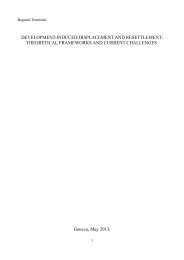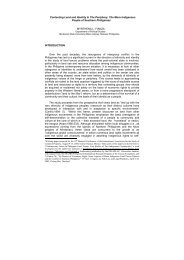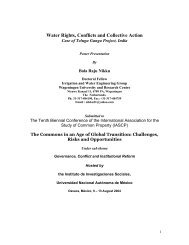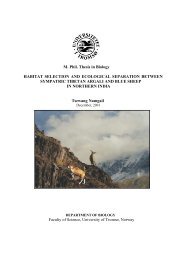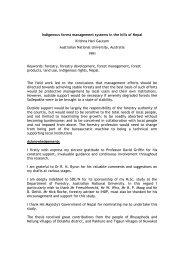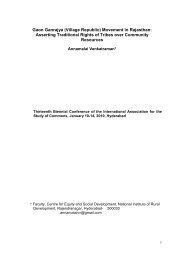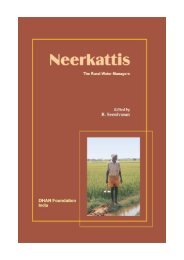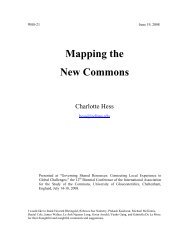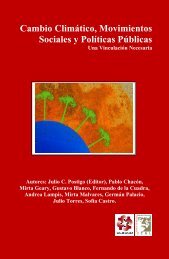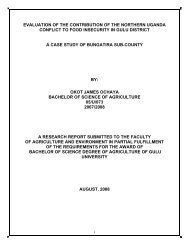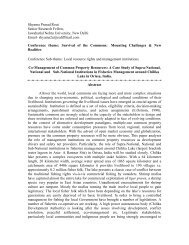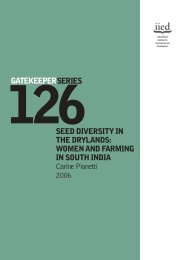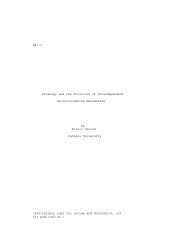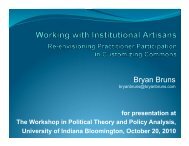<strong>The</strong> burgeoning field of traditional environmental/ecological knowledge study hascertainly shown that <strong>the</strong> world’s indigenous peoples have long-term knowledge about<strong>the</strong>ir own territories that often exceeds scientific data in both detail and understanding. Assurvival was <strong>the</strong> driving force that shaped systems of interaction with <strong>the</strong> natural world,we suggest that it was also <strong>the</strong> catalyst for developing <strong>the</strong> ethics and practice ofstewardship. In order for <strong>the</strong> effort expended on encouraging resource abundance orexpansion to be attractive, a system of proprietary control to ensure exclusive harvestrights is required.Control and exclusion of o<strong>the</strong>rs from harvesting sites and areas may well be <strong>the</strong> primaryunderpinning for any concept of resource ownership. As our documented examples anddiscussion demonstrate, by <strong>the</strong> time of European contact in <strong>the</strong> late 1700s, First Nations’territorial systems of ownership reflected a high level of complexity and diversity, as did<strong>the</strong>ir languages and cultures. Equally complex systems of traditional resourcemanagement that must have co-developed with <strong>the</strong>se ownership principles are alsoclearly suggested in <strong>the</strong> examples. In <strong>the</strong> case of <strong>the</strong> Nuu-Chah-Nulth, Hereditary ChiefEarl Maquinna George, quoted earlier in his explanation of <strong>the</strong>ir Hahuulhi system,highlights <strong>the</strong> extent to which culture, ownership and resource management areinterwoven (pers comm. to NT, May 10 1996)....And <strong>the</strong>y talked about it at <strong>the</strong> potlatch because big name hereditary chiefs wererespected. And <strong>the</strong>y talked about how <strong>the</strong> system would work. That <strong>the</strong>y wereallowed to fish in <strong>the</strong> territory that had a good seasonal salmon run.... <strong>The</strong>re werespecial people that looked after <strong>the</strong> creek, not <strong>the</strong> chief. <strong>The</strong>y had people thatworked to do <strong>the</strong> cultural work of <strong>the</strong> stream.Salmon makes a good example for examining <strong>the</strong> magnitude of First Nations’ harvestingin traditional times, since anthropologist Gordon Hewes (1973:136) has calculated <strong>the</strong>per-capita average annual salmon requirements at 230 kg (500 lbs). A population of100,000 would have consumed 23,000,000 kg; 200,000 -> 46, 000,000: and 400,000 ->92,000,000 kg (or 100,000 tons) annually. Yet, for some time after European contact,reports and anecdotal accounts describing prodigious salmon abundance are frequentlyfound in <strong>the</strong> archival records. It is not likely that such abundance could have endured thisharvest pressure without strictly controlled systems of territorial and fishing siteownership coupled with effective stewardship practices.Heiltsuk hereditary chief Edwin Newman eloquently captures <strong>the</strong> essence of thisrelationship between survival, exclusive ownership and stewardship in a videodocumentary which examines aboriginal fisheries: Laxwesa Wa, <strong>The</strong> Strength of a River:Survival of Heiltsuk people is totally dependent on <strong>the</strong> resources of <strong>the</strong> sea. Wehave nothing else . . .Every family owned fishing sites in <strong>the</strong> old days, [you]know. You got areas where people dried herring eggs. Certain families ownedcertain areas. Not everybody went to <strong>the</strong> same place; you had to have a right togo <strong>the</strong>re. We looked after all <strong>the</strong> salmon streams. We even had our own halibutgrounds, our own black cod grounds and our salmon streams; we looked after<strong>the</strong>m. We made sure that nothing was going to happen to <strong>the</strong> runs that came back.We never abused it in any way. So we are natural conservationists. We’ve been20
told stories by our ancestors about how people were banished from ourcommunities for abusing <strong>the</strong> resource of <strong>the</strong> sea or playing with it.Chief Newman explicitly outlines traditional systems of ownership and care-takingobligations where exclusive use rights are held by family groups and <strong>the</strong> social controlswielded by <strong>the</strong> community, at least in <strong>the</strong> context of infractions against nature, could besevere. This severity may echo <strong>the</strong> serious consequences of mistakes made by previousgenerations, often retold in <strong>the</strong> instructive stories and legends of oral history recorded byBoas, Swanton and many o<strong>the</strong>rs. We believe that over <strong>the</strong> millennia of humandevelopment and its diverse cultural expression, <strong>the</strong> resource management strategies ofindigenous or aboriginal peoples go beyond our present concept of conservation tosystems entirely focused on perpetuation of abundant human-balanced, human-servingnatural systems. As a rule of thumb for maintaining a sound resource base, we often hearfrom North American Aboriginal peoples that any decisions to be made that may affectnatural systems must be considered many generations into <strong>the</strong> future.Aboriginal Stewardship Past and PresentAboriginal stewardship is widely acknowledged but an understanding of its practices isreally just beginning to emerge. As noted previously, epidemics and acculturation haveeffected great loss of knowledge. So too has <strong>the</strong> strong dependence on ‘store bought’,facilitated by employment in resource extraction industries, ra<strong>the</strong>r than wild harvesting;survival seems no longer dependent on <strong>the</strong> ability to maintain and perpetuate local foodresources. With many Aboriginal people, having learned to depend on imported productsbought in stores, we believe that <strong>the</strong> obligation to pass on or learn <strong>the</strong> old stewardshiptraditions has severely diminished over recent generations. As anthropologist EugeneAnderson (1996:38-39) wrote, "We have many evidences of careful resourcemanagement. . . Unfortunately, no thorough description is possible, since <strong>the</strong> relevantmechanisms were gone by <strong>the</strong> late nineteenth century. . .." Fortunately though, with <strong>the</strong>current resurgence of First Nations’ cultures, and growing interest in traditionalknowledge, we continue to add to our understanding of <strong>the</strong> old ways (Kuhn and Duerden1995; Turner & Atleo 1998; Turner et al. in press 2000) and can begin to define what ismeant by "Aboriginal stewardship".Traditional systems of stewardship have been a dynamic cultural integration with localecosystems which in turn were substantially influenced by practices that enhancedproductivity, stability and diversity of harvested resources. <strong>The</strong> long term outcome was<strong>the</strong> perpetuation of human-balanced ecosystems. Aboriginal stewardship clearly linksspirituality, culture, and survival. <strong>The</strong>se elements culminate in a lifestyle ethic thatobliges all members of a group to actively participate in environmental husbandry ofessential resources, in a way that has been adapted to <strong>the</strong>ir locality over an extendedperiod of time.We think it is critical to make <strong>the</strong> distinction here, between "perpetuation" in stewardshipand "conservation" or "sustainability" in management of resources. Gifford Pinchot, <strong>the</strong>first director of <strong>the</strong> United States Forest Service, believed that "<strong>the</strong> first duty of <strong>the</strong>human race is to control <strong>the</strong> earth it lives on". He defined and promoted conservation as"<strong>the</strong> use of <strong>the</strong> natural resources for <strong>the</strong> greatest good of <strong>the</strong> greatest number for <strong>the</strong>21
- Page 2 and 3: settlement. Notably, the template f
- Page 4 and 5: Indigenous Group(Language Family);R
- Page 6 and 7: Sekani, Dakelh or Carrier,Tsilhqot
- Page 8 and 9: families," and the use by others re
- Page 10 and 11: ask permission to use the traps fro
- Page 12 and 13: ... in the case of a salmon stream,
- Page 14 and 15: As well as gardens, patches and sta
- Page 16 and 17: Charles Newcombe (1902: Haida - Ksa
- Page 18 and 19: • Succession:: Territories and si
- Page 22 and 23: longest time", which became the fou
- Page 24 and 25: Barnett, Homer G. 1955. The Coast S
- Page 26 and 27: Hamori-Torok, Charles. 1990. Haisla
- Page 28 and 29: Richardson, Allan. 1976. The Contro
- Page 30: email to Nives Dolsak and Elinor Os



